
Fukawa-Yumoto and Sounose, Nagato City, Yamaguchi Prefecture Fukawa Goyo In 1657, Li Shakuko, the founder of the Hagi ware tradition, moved with his descendants to the mountains of Fukawa-Yumoto Sounose in Nagato and established the Sounose Hagi ware collective under the command of the local lord. Here we introduce five kilns still proudly making Hagi ware in this small village. (staff) text:Nao Ohmori, Tomoko Honma photo:Seitarou ikeda(STRIKE studio),Ryusuke Honda(bird and insect)
He seeks to create his own world of Hagi ware by bringing out the true appeal of Hagi clay
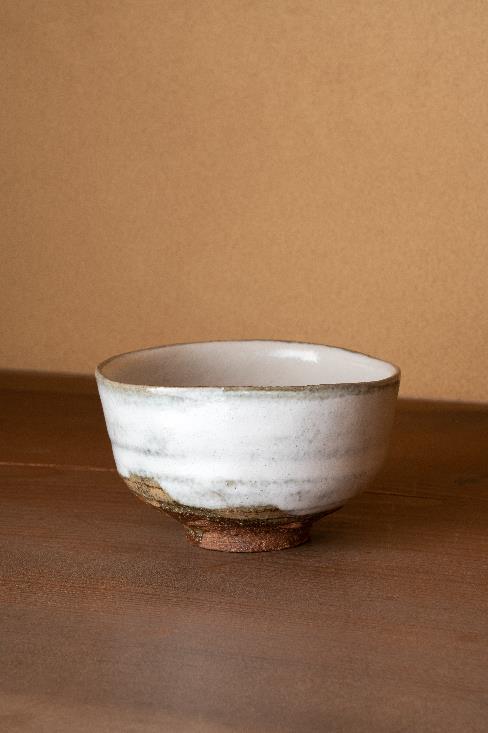
White glazed bowl
This tea bowl was made with a base of Mishima clay coated with Daido clay and decorated with a straw ash glaze before firing in a climbing kiln. Shinbei, the 15th generation potter, is working on a new mode of expression; “I want to create a new approach that further develops the contrast between the glaze and clay,” he says.
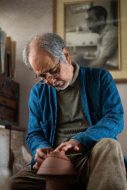
<name/profile>
Shinbei Sakakura, 15th generation
Shinbei Sakakura was born in Nagato City, in 1949. He graduated from Tokyo University of the Arts in 1972 with a degree in sculpture, and the university’s graduate course in ceramics in 1974. In 1989, he received the Yamaguchi Prefecture Arts and Culture Promotion Encouragement Award. In 2013, he was certified as an Intangible Cultural Property Holder for his Hagi ware and is also an official member of the Japanese Kōgei Association.
http://sakakurashinbe.com/
The Sakakura Shinbei Kiln is located at the far end of the Sounose valley. This is one of the famed potteries that have continued to produce ceramics as the direct heirs to the founder of Hagi ware, Li Shakuko. 15th generation potter Shinbei Sakakura, whose grandfather, 12th generation potter also named Shinbei Sakakura, known as the father of the revitalization of Hagi ware, took over the kiln himself at the age of 26. This was because his father, the 14th generation Shinbei, suddenly collapsed from illness and passed away at the early age of 58.
“I was only able to work alongside my father for three months. I learned a great deal from standing behind my father and watching him work diligently producing ceramics despite his illness.”
He subsequently took the name Shinbei Sakakura XV at the age of 29. He says that he found the world of Hagi ware that he was seeking during his strenuous life as both an artist and manager of the pottery.
“Hagi clay has a warmth that soothes people. I want to bring out the best of that clay during my work. I combine Daido, Mishima, and Mitake clays, coat them with straw ash or transparent glazes, and fire them in my climbing kiln. The resulting color variations expand through alteration during firing. As I work and express myself through this work, I constantly ask myself, how can I bring out the charm of the clay?”
He explains that the painted works produced using a painting knife normally used in oil painting was an approach he began to bring out the beauty of the clay. “My hope is to give birth to works that communicate to the future that, as a person who exists within the history of Hagi ware, it is OK for the 15th generation Shinbei to be this creative.”
He looks within himself in pursuit of a type of Hagi ware never seen before
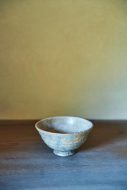
Hagi tea bowl, Daido powdered
This tea bowl is produced using a traditional technique with Hagi ware and Daido clays, but it is glazed and then fired rather than being fired unglazed. Unlike the typical Hagi ware which prefers the soft and quiet aspect of the clay, the aim was to give a better sense of the power of the clay and fire with the burnt texture and unique alterations during firing.
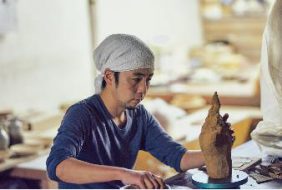
<name/profile>
Masahiro Sakakura
Masahiro Sakakura was born in Nagato City in 1983. He graduated from the Tokyo University of the Arts in 2007 with a degree in sculpture, and completed his graduate studies in sculpture at the same university in 2009. He then studied pottery techniques for two years at the Kyoto Municipal Institute of Industrial Technology and Culture, after which he entered the world of ceramics in 2011 under his father, 15th generation potter Shinbei Sakakura.
“What is Hagi ware? I want to discover the underlying answer to that question,” says Masahiro Sakakura with sparkling eyes.
Heir to the famed Sakakura family’s Fukawa Kiln, Masahiro started his own career in pottery about 10 years ago.
Masahiro explains, “I had no reservations at all about entering this profession.” He returned to his hometown of Fukawa-Yumoto in Nagato after graduating university and commuted to Kyoto for two years by train.
Since beginning his career as a potter, he began the habit of traveling through the mountains in order to explore the nature of clay as a material. He explains, “My five senses are sharpened in the mountains. Sometimes I encounter animals, and when I’m digging up clay, I imagine that people have been creating fired pottery from clay since the Jomon period. The clay of this area is what inspires me to bring out the appeals of that clay.”
It is not Hagi ware itself that Masahiro wishes to express despite following the Hagi ware techniques. He explains his own concept of Hagi ware, saying that “Now is not the time to define Hagi ware by its colors and techniques. I would rather be more open minded about its definition.”
He continues, “In my own mind, Hagi ware are the creations my father produces. I want to carry on that tradition as the official output of the Sakakura Shinbei Kiln,” and adds, smiling, “But I myself hope to create works that have never been seen before, that will be said to be unlike Hagi ware. The style I inherit from my father and my own style will be similar but different, but not necessarily unalike. I think they can both coexist.”
Masahiro’s flexible but brave attitude will surely be the beginning of a new age of Hagi ware.
A personal approach to pottery found through trial and error
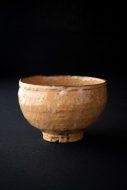
Hagi ware tea bowl
Exhibited at the 64th Japanese Traditional Crafts Exhibition. Made of Mishima and Daido clay, and ash glazed after firing.
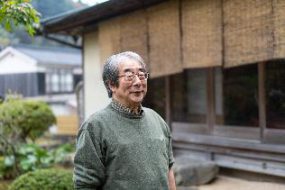
<name/profile>
Sadatsugu Shinjo, 14th generation potter
Sadatsugu Shinjo was born in Nagato City in 1950. He completed his graduate studies in sculpture at Tokyo University of the Arts in 1977 and later completed a traineeship in ceramics at the Kyoto Municipal Institute of Industrial Technology and Culture.
Sadatsugu Shinjo is a descendant of Sukeemon Akagawa, who in turn was a descendant of Li Shakuko. After the death of his father, the 13th generation potter Kanzan Shinjo, Sadatsugu decided to attend Tokyo University of the Arts because he felt he was yet unable to take over the kiln at that time. He returned to the Sounose valley after studying sculpture at university and learning pottery in Kyoto. “When I started, I wanted to explore the possibilities of Hagi ware using traditional clays and glazes, and different strengths of flame in the climbing kiln. A tea bowl is an item that fills the space between your hands comfortably and gives a sense of the space within. I consider the space in which the piece exists as I carry out my pottery.”
I will continue to explore my interests and create pottery that expresses myself
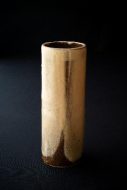
Flower vase
This flower vase is formed using red clay that combines Daido clay with iron-rich Mishima clay. It is then coated with white decorative clay and an earthen ash glaze. It presents an appealing contrast between the richly expressive gradation on the outside and the uncoated interior.
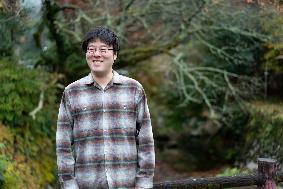
<name/profile>
Akihiro Shinjo
Akihiro Shinjo was born in Nagato City, 1985. He graduated from Waseda University with a degree in Literature in 2010. He began pottery after completing training at the Kyoto Municipal Institute of Industrial Technology and Culture in 2013. He currently releases works while participating in numerous group exhibits.
“I am not interested in creating pieces that look like those of my father. However, I grew up using tableware my father created on a daily basis from a small age, so my father’s works have had a great influence on my own view of pottery.” After graduating from university, Akihiro studied the basics of ceramics, such as materials and techniques, at the Kyoto Municipal Institute of Industrial Technology and Culture, before working under his father Sadatsugu beginning in 2011. “I believe my interests change gradually as I do this work. Right now, I’m at the stage of trial and error, depending on my own physiological senses and my dubious knowledge of ceramics.”
Bringing out the beauty of Hagi ware clay through a variety of expressions
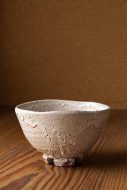
Split high base tea bowl
This piece offers an elegant coloration from the white Hagi glaze. “I place importance on maintaining elegance when creating my tea bowls.”
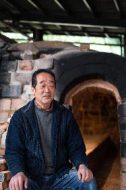
<name/profile>
Tobei Tahara
Tobei Tahara was born in Nagato City in 1951. He studied under Shigetoshi Nakazato after graduating from the Musashino Art University Graduate School in 1975. He was selected for the Japanese Traditional Crafts Exhibition for the first time in 1990 and is the recipient of numerous awards.
The Tahara Tobei Kiln was founded by Sukezaemon Akagawa, one of the original potters in Sounose. The 13th generation potter Tobei Tahara studied under the Karatsu potter Shigetoshi Nakazato after studying at the Musashino Art University Graduate School. “I have had many opportunities to learn, such as being able to see the works of the 12th generation Tobei objectively, and the techniques I learned in Karatsu.” Since Tobei returned at 26, he has honed his skills on a daily basis in order to bring out the true expression of the clay that is characteristic of Hagi ware. “When I achieve the look I am aiming for, whether a soft or rough expression, I look for what I need to do next. I hope I can continue to evolve in the future as well.”
Searching for a new approach to Hagi ware while showing respect for history and tradition
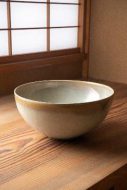
Vase with flowing white glaze
The flowing white glaze in this piece was inspired by a pottery shard excavated from an old kiln in Sounose. The greenish expression formed by layers of straw ash and pine ash glaze creates a beautiful result. Local clays were also used at the time when the old kiln was actively used, and this flowing white glaze piece was created by adding other clay to Daido clay to achieve a similar result.
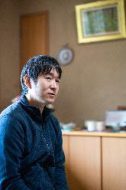
<name/profile>
Takao Tahara
Takao Tahara was born in Nagato City in 1982. He completed his studies in sculpture at the Tokyo University of the Arts Graduate School of Fine Arts in 2007. He then studied under Seiya Toyoba, a potter in Mino, in 2010, and subsequently under the 13th generation Tobei Tahara in 2011. He is the recipient of numerous awards, such as the 2020 Japan Ceramics Association Award. He is currently a full member of the Japan Kōgei Association.
http://tahara-tohbe.com
Born as the eldest son of the 13th generation Tobei Tahara, it seemed perfectly natural for Takao to enter the potter profession. He majored in sculpture at the Tokyo University of Arts, and then the graduate school of the same, to learn the attitude and mindset of artistic creation. He then returned to Sounose and began making pottery in 2011, and since then, his contributions as a young potter to carry on the Hagi ware tradition have been remarkable. “I am currently at the stage where I try whatever interests me at the time in the pursuit of form. My hope is to familiarize people with a freer range of works as being part of Hagi ware to overcome the more limited perception.” Takao freely engages in his creative work with enthusiasm without feeling weighted down by the pressure of carrying on a famous name in pottery.
Zen’emon Sakakura X
Pioneering the future of Hagi ware without being bound by traditions or stereotypes
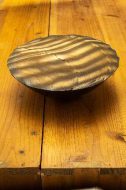
Moonlight ware
Beautifully coloring from a unique local glaze this piece is somewhere between a piece of tableware and an art object.
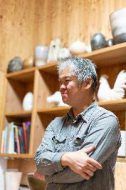
<name/profile>
Zen’emon Sakakura
Zen’emon Sakakura was born in Nagato City in 1969. He graduated from Kobe Design University in 1994. He began training at a kiln in Mino after completing training at the Tajimi City Pottery Design and Technical Center in 1996. In 2000, he returned to Sounose and became the 10th generation Zen’emon Sakakura in 2006.
www.zen-emon.com
This kiln was originally founded during the Edo Period as the Sakakura Gorozaemon Kiln of the new Sakakura family. The kiln was closed during the time of the 7th generation Goro Sakakura, but rekindled by the 10th generation Zen’emon Sakakura. Zen’emon majored in furniture at the Kobe Design University, but switched to pottery out of his desire “not to waste the materials.” He returned to Sounose after studying at the Tajimi City Pottery Design and Technical Center and then training with a potter in Tajimi City. “In a sense, this kiln started from scratch. I want to explore new paths without being restricted by the stereotypes of Hagi ware. When I create ceramics, I keep an awareness of the presence the piece has when placed in a space.”
Sumiharu Sakata
Approaching pottery from a frank perspective by leveraging his training in the tea ceremony
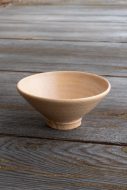
Tea bowl
This bowl is created with a blend of Daido and Mishima clays. It is a traditional example of Hagi ware coated in straw ash glaze.
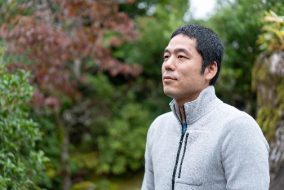
<name/profile>
Sumiharu Sakata
Sumiharu Sakata was born in Nagato City in 1978. He completed a course in Ceramics at the Kyoto Municipal Institute of Industrial Technology and Culture in 2012. He began training at Horinouchi Choseian the same year and began creating pottery at Deika Gama in 2008.
Originally founded by Li Shakuko, the Sakakura Gorozaemon family split into the two during the 7th generation in the Edo period. Sumiharu Sakata is the 16th generation potter of the lineage. “I am the second son of the 15th generation potter Deika Sakata, so I did not originally intend to carry on the family business.” He however decided to enter the world of pottery at the age of 30, and completed his studies at the Kyoto Municipal Institute of Industrial Technology and Culture. He then went on to study the tea ceremony at Horinouchi Choseian. “I believe this experience to be useful in producing tea bowls which can be said to be the origin of Hagi ware,” he says.